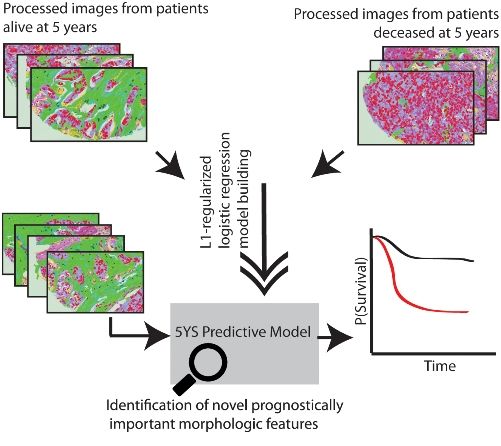Stanford Researchers Build ‘Digital Pathologist’ for Breast Cancer
A team of Stanford engineers and pathologists have trained computers to analyze breast-cancer pathology slides - and the machine is more accurate than the assessments of man (and woman), the researchers said.
A team of Stanford engineers and pathologists have trained computers to analyze breast-cancer pathology slides - and the machine is more accurate than the assessments of man (and woman), the researchers said.
The software, called Computational Pathologist, or C-Path, applies artificial intelligence to the problem of analyzing images of cancerous tissues and predicting patient survival. It’s described in the Nov. 9 issue of Science Translational Medicine.
To train C-Path, the researchers used existing tissue samples taken from patients whose prognosis was known. The software assessed images, measuring tumor structures and trying to use those structures to predict patient survival. By comparing results against the known data, the system adapted its models to better predict survival and gradually figured out what features of the cancers matter most and which matter less in predicting survival.
“In essence, the computer learns,” said Daphne Koller, PhD, professor of computer science and senior author of the paper.
Pathologists consider three features for evaluating breast cancer cells: what percentage of the tumor is comprised of tube-like cells, the diversity of the nuclei in the outermost (epithelial) cells of the tumor, and the frequency with which those cells divide. These three factors are judged by sight with a microscope and scored qualitatively to stratify breast cancer patients into three groups that predict survival rates.
“Pathologists have been trained to look at and evaluate specific cellular structures of known clinical importance, which get incorporated into the grade. However, tumors contain innumerable additional features, whose clinical significance has not previously been evaluated,” said Andrew Beck, MD, a doctoral candidate in biomedical informatics and the paper's first author.
“The computer strips away that bias and looks at thousands of factors to determine which matter most in predicting survival,” added Koller.
C-Path assesses 6,642 cellular factors. Once trained, C-Path was asked to evaluate tissues of cancer patients it had not checked before and the result was compared against known data. The researchers used two independent cohorts of breast cancer patients (248 from the Netherlands Cancer Institute and 326 from Vancouver General Hospital). The system’s prognostic model score was strongly associated with overall survival, the researchers found. This association was independent of clinical, pathological, and molecular factors.
C-Path yielded results that were a statistically significant improvement over human-based evaluation.
What's more, the computers identified structural features in cancers that matter as much or more than those that pathologists have focused on traditionally. In particular, they discovered that the characteristics of the cancer cells as well as the surrounding stroma cells were both important in predicting patient survival.
“We built a model based on features of the stroma - the microenvironment between cancer cells - that was a stronger predictor of outcome than one built exclusively from features of epithelial cells,” said Beck. “The stromal model was as predictive as the model built from both stromal and epithelial features.”
The Stanford findings add weight to what many scientists have been contending for some time: that cancer is an “ecosystem,” and that clinically significant information can be obtained by careful analysis of the complete tumor microenvironment.
“Through machine learning, we are coming to think of cancer more holistically, as a complex system rather than as a bunch of bad cells in a tumor,” said Matt van de Rijn, MD, PhD, a professor of pathology and co-author of the study. “The computers are pointing us to what is significant, not the other way around.”
Van de Rijn does not see computers replacing pathologists. “We’re looking at a future where computers and humans collaborate to improve results for patients across the world,” he said.

Can Ultrasound-Based Radiomics Enhance Differentiation of HER2 Breast Cancer?
March 11th 2025Multicenter research revealed that a combined model of clinical factors and ultrasound-based radiomics exhibited greater than a 23 percent higher per patient-level accuracy rate for identifying HER2 breast cancer than a clinical model.